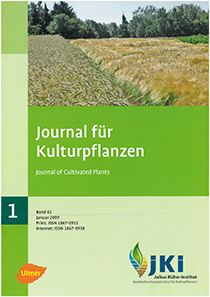Prevention of plant crown gall tumor development by the anti-malarial artesunate of <em>Artemisia annua</em>
DOI:
https://doi.org/10.5073/JfK.2009.01.05Keywords:
Agrobacterium tumefaciens, crown gall, Cucumis sativus, downy mildew, growth promotion, powdery mildew, Ricinus communis, vascularizationAbstract
The antimalarial drug artesunate, a sesquiterpene trioxane lactone derivative of artemisinin from Artemisia annua L., is known for its extraordinary inhibitory effects on plasmodia and trematodes and also for suppressing the proliferation of human tumor cells. In the present study the effect of artesunate was investigated on rapidly dividing plant cells in Agrobacterium tumefaciens-induced crown gall tumor and wound callus cells at the model plant Ricinus communis. Low concentrations of artesunate (10 µM) were sufficient to completely suppress crown gall development upon permanent application. Within three weeks the shoots of artesunate-treated plants attained about double the size of the tumor-bearing plants and showed abundant, healthy and larger leaves. Moreover, artesunate retarded wound callus development and induced superficial necroses. However, artesunate did not prevent or inhibit infections of cucumber leaves by powdery (Podosphaera xanthii) or downy mildew (Pseudoperonospora cubensis). Young cucumber leaves showed symptoms of phytotoxicity upon treatment with very high artenusate concentrations of 100 µM and higher. Lower concentrations (50 µM or less) did not cause visible necrotic lesions. These novel findings suggest a general and conserved basic mode of action of artesunate in human, animal and plant cells, except of phytopathogenic fungi. A possible application of artesunate for biological control of crown gall development in grapevine and precious fruit trees is discussed.
Published
Issue
Section
License
The content of the journal is licensed under the Creative Commons Attribution 4.0 License. Any user is free to share and adapt (remix, transform, build upon) the content as long as the original publication is attributed (authors, title, year, journal, issue, pages).
The copyright of the published work remains with the authors. The authors grant the Journal of Cultivated Plants, the Julius Kühn-Institut and the OpenAgrar repository the non-exclusive right to distribute and exploit the work.







